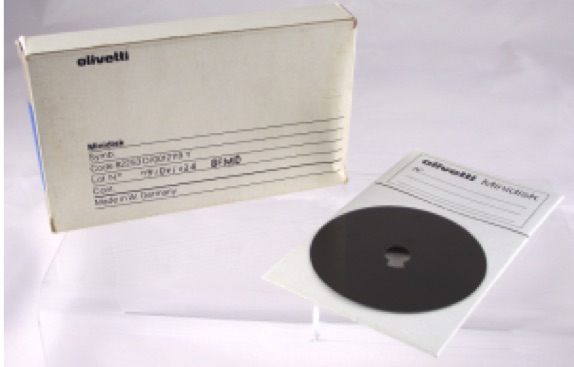History (1977): Olivetti minidisc
3KB, for use in P6040 minicomputer
This is a Press Release edited by StorageNewsletter.com on October 16, 2018 at 2:18 pmThis article was published by the Museum of Obsolete Media.
Olivetti minidisc (1977-early 1980s)

The Olivetti minidisc (not to be confused with the magneto-optical Sony MiniDisc of 1992) was a magnetic floppy disk format for data storage designed by Olivetti for use in its P6040 minicomputer of 1977 which had a built-in disk drive.
The P6040 used an Intel 8088 processor, and used a dialect of BASIC called Tiny BASIC that used a subset of BASIC commands. Output was displayed on a one-line red diode display, or on the built in printer. Although it was a computer, in practice it was more like a programmable calculator or a low-end ledger machine.
The disk drive used 2.5-inch mylar discs without a protective cover, capable of holding just 3KB of data (which was ample considering the P6040 had only 1KB of RAM for user data, though this could be expanded to 3 KB).
The disk was single-sided and the non-recordable side had an identification number stamped on it, since there was no other way of identifying a disk once it was taken out of its storage envelope.
Unlike later floppy disks, data is not stored in tracks and sectors, but is stored in a single spiral track like a phonograph record.
Reading or writing to the disk was done in a single operation, so writing to the disk overwrote all the existing contents.
The advantage with this system was that it was cheaper to produce than a standard floppy disk drive, so whereas the larger P6060 system used a built-in 8-inch floppy disk drive, the P6040 made do with the cheaper minidisc system.
The limited capacity of the disk meant that a read or write of the entire disk could be carried out in between 6 and 11.5 seconds.
As well as the P6040, Olivetti used the minidisc in 1978 in its TES (Text Editing System) 401 word processing system, where capacity was increased to 7.5KB, and in the Business Computer System models BCS 2020 and BCS 2030 of 1979.













 Subscribe to our free daily newsletter
Subscribe to our free daily newsletter

